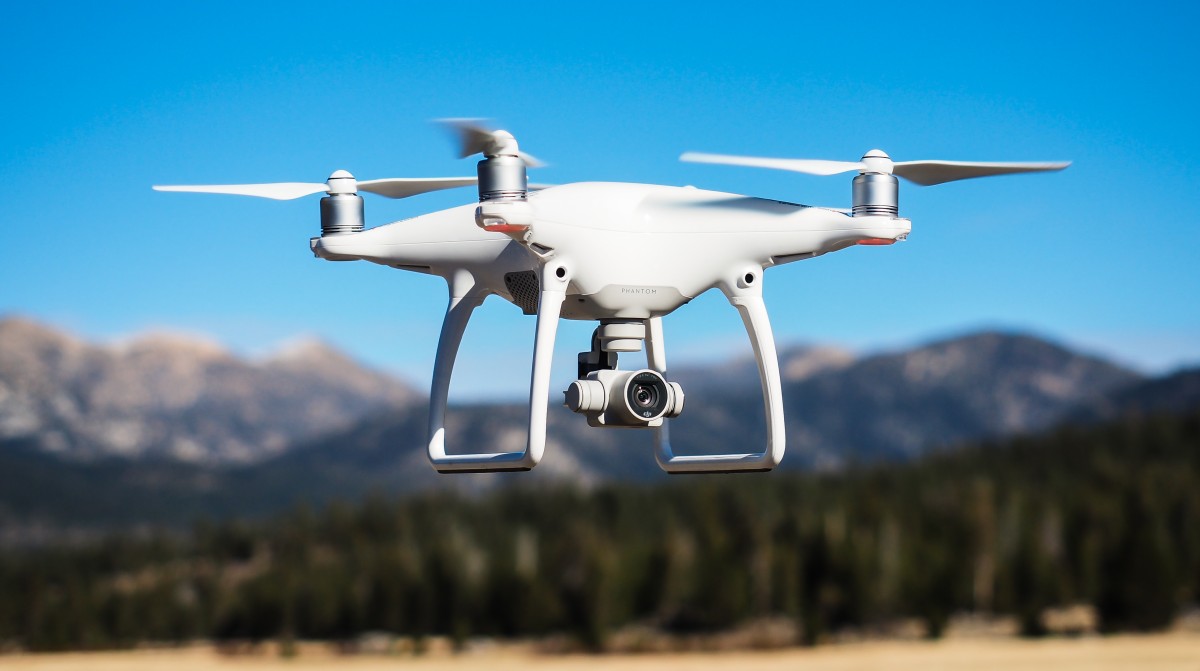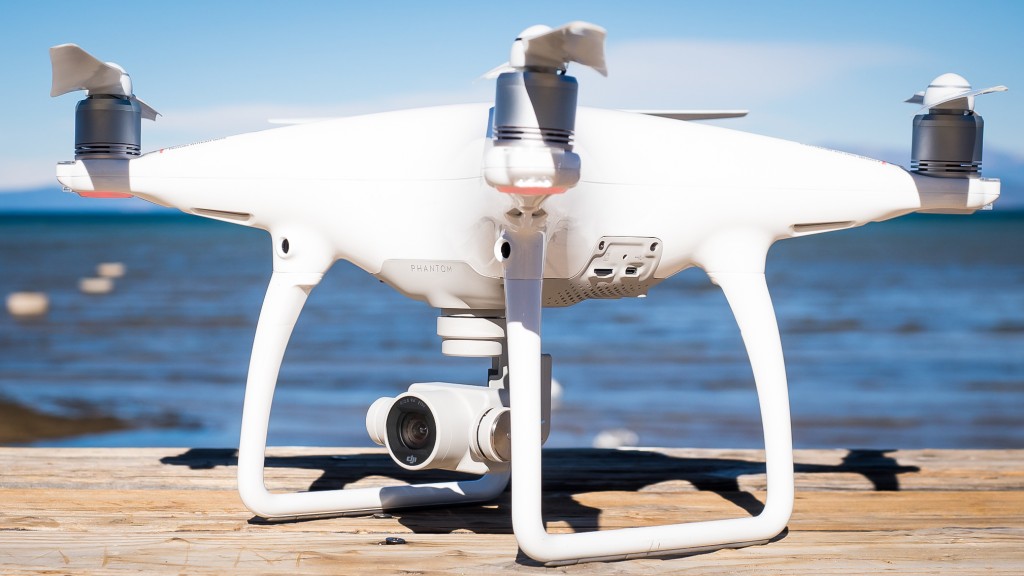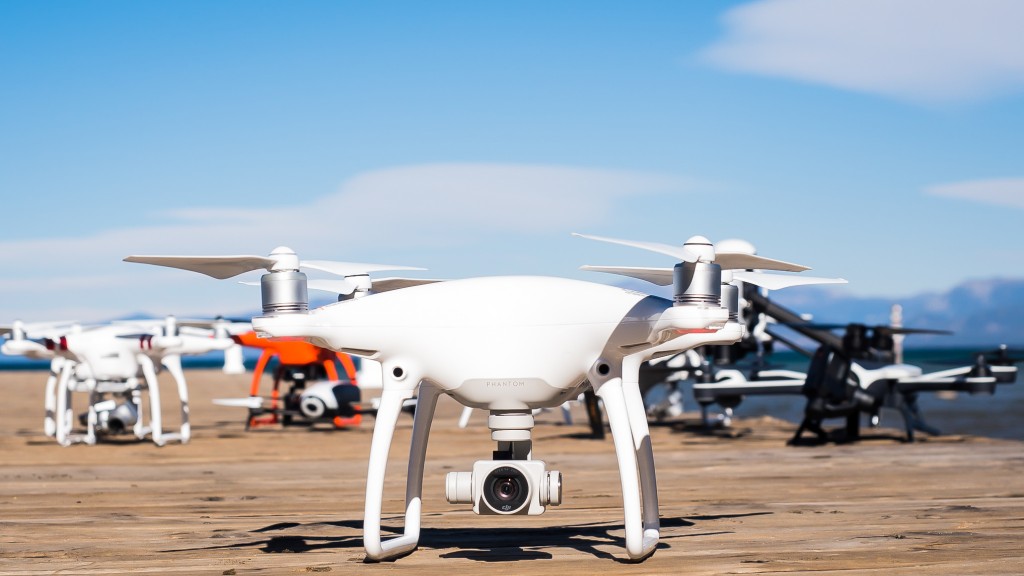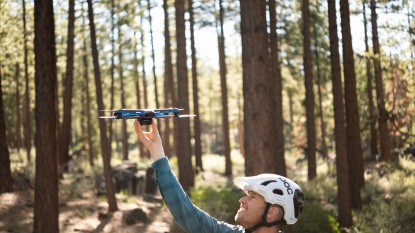The Phantom 4 was replaced by the Phantom 4 Pro series in November 2016. Though it does not share the “Pro” moniker of its successors, in our opinion, it really blurs the line between amateur and professional grade. Both the drone itself and the camera gimbal are incredibly stable. This combination creates the kind of silky smooth panning landscape shots you'd expect to be accompanied by a David Attenborough voiceover. That stability translates to more demanding flying as well, like following a fast moving subject on a winding trail. Top that off with a sharp, 4K camera, best in class flight performance, a high-quality video downlink, and a responsive controller, and you've got a top-notch drone.
DJI Phantom 4 Review
Our Verdict
The Phantom 4 was replaced by the Phantom 4 Pro series in November 2016. Though it does not share the “Pro” moniker of its successors, in our opinion, it really blurs the line between amateur and professional grade. Both the drone itself and the camera gimbal are incredibly stable. This combination creates the kind of silky smooth panning landscape shots you'd expect to be accompanied by a David Attenborough voiceover. That stability translates to more demanding flying as well, like following a fast moving subject on a winding trail. Top that off with a sharp, 4K camera, best in class flight performance, a high-quality video downlink, and a responsive controller, and you've got a top-notch drone.
Our Analysis and Test Results
Performance Comparison
Video Quality
The Phantom 4 earned the score of 9 out of 10 in our video quality testing. This is just off the top score of 10, appreciably better than the lowest scoring gimbal drone, which earned a 6, and orders of magnitude better than the worst scoring non-gimbal model, which earned a 3. We found the Phantoms 4's camera, with its 4K resolution, to produce crisp images with bright, accurate colors. The only weak point in the camera's ability are some color aberrations that are created when pointing into the sun. These shots don't look terrible by any means, they just are a bit flatter, pop less than normal, and have some distracting lens flares. This is the main disadvantage of the Phantom 4 when compared to the Phantom 4 Pro+, which has an adjustable aperture that can better deal with direct sunlight. The upside is that DJI does provide ample amounts of adjustment and fine tuning in all their products, so those that want to jump down the settings rabbit hole to optimize these kinds of shots will have the ability to do so.
Where the Phantom 4's video quality really stands out is not in the camera itself, but in the stabilizing gimbal it is attached to. In our test flights this high-quality gimbal kept the camera as steady as a rock. Even when we whipped the drone around like an overactive six-year-old that stole his mom's espresso, the horizon stayed level and there was no discernible camera shake. This incredible stability produces shots that a layperson would just assume were taken from a helicopter with some large stabilizing apparatus. With this performance you can go ahead and attempt any shot you'd like without any worries about camera shake. In this aspect, the Phantom 4 is on par with the Phantom 4 Pro+.
The Phantom 4 does have some minor issues with propellers intruding on the camera's view. This problem generally only presents itself when flying very aggressively, and is exacerbated when the camera is pointed towards the sun. For the majority of shots you'll want to compose propellor intrusion will not be an issue. However, if you want to turn on sport mode and unlock the Phantom 4's full 40+ mile-per-hour potential, you may have to make sure the camera is tilted down to avoid getting the propellers in the shot.
Ease of Use
We found most of the drones we tested were fairly user friendly, and the Phantom 4 was one of the many that shared the score of 8 out of 10 in this metric. This was just off the top score of 9 and well above the low score of 3.
Out of the box, it was straightforward to charge and install the battery, properly install the propellers, and charge up the controller. The DJI GO app is similarly easy to install on the smartphone or tablet of your choice. Linking the drone, controller, and smartphone was easy; just remember you'll need a USB cable to connect your smart device to the controller. Opening the DJI GO app prompts you to create an account and runs you through the setup process. Considering the complexity of this device, we found this process very straightforward and intuitive.
The Phantom 4's controller applies the same basic design principles as all of DJI's controllers. The joysticks are fairly long and have beveled edges, This provides good grip and allows you to fly either with just your thumbs or pinching each joystick between your thumb and forefinger. The joysticks provide just the right amount of resistance and tactile feedback, allowing you to make precise and controlled maneuvers. There is a nice clamp that secures your phone or tablet to the controller and adjusts its exact angle. The phone or tablet is used to display the live video feed from the camera and includes a number of menu options around the periphery of the screen. These menus can feel a bit crowded and daunting, but can easily be ignored until you're more comfortable with the intricacies of the drone.
Even in your first flight, the Phantom 4 does not feel daunting to fly. A large red record button on the on-screen display makes it clear whether or not you're recording. Taking off is easily accomplished by pressing a small takeoff icon on the screen. Upon pressing the button an unlock bar appears that you must slide. This prevents you from accidentally pressing the button and taking off. Sliding the unlock bar automatically brings the drone off the ground and into a stable hover at about eye level. With takeoff out of the way the Phantom 4's ergonomic controls quickly become second nature, and the high quality live video downlink makes it easy to frame your first shots. There are plenty of battery warning indicators to remind you when it's time to bring the copter back home. Once you maneuver it back above the point where you'd like it to land you can again press a land icon, slide a lock bar, and the drone will complete an automatic and controlled landing. Odds are you'll be nervous during your first flight with thoughts of crashing your new investment into a tree, but we feel those anxieties will quickly dissipate as you realize how easy it is to fly.
Flight Performance
The Phantom 4 was a clear frontrunner in our flight performance testing, sharing the top score of 9 out of 10 with the Phantom 4 Pros. This put it decently ahead of the lowest performing gimbal model, which scored a 6, and well in front of the non-gimbal models, both of which scored a 5.
Here again the Phantom 4 largely scored well because of stability. In our testing it was incredibly stable in takeoffs and landings, was nearly flawless when we asked it to stay in a stationary hover, and was able to easily hold its line of flight, even when the wind had other ideas. That stability translated to its autonomous flight functions. Its orbit point of interest and cable cam functions both resulted in predictable, stable flights that produced correspondingly stable footage. Although we are generally wary of the automatic return to home function, we had no issues when testing this feature on the Phantom 4.
On top of being stable, the Phantom 4 was also one of the most capable fliers we tested. In sport mode it can exceed 40 miles per hour, stop on a dime, and generally whip around like a Cooper's hawk chasing a sparrow. In many ways, it feels like a racing drone disguised as one of the best camera drones you can buy. Did we mention it also provides 28 minutes of maximum flight time?
Video Downlink
The Phantom 4 shared the score of 9 out of 10 in our video downlink testing with the DJI Inspire and the Phantom 4 Pro. Scores for the gimbal models in this metric ranged from 10 to 9, with the non-gimbal models scoring 3 and 4. The video quality of the downlink was of such a high quality during all of our flights that looking at it felt immersive. This quality never wavered, even when we flew the drone 3000 feet away from the controller. The on-screen menu does cut off some of the video downlink, which can be annoying if you're trying to perfectly frame a particularly finicky shot. The menu can be hidden by swiping down on the screen, which completely eliminates this problem. However, some may feel a bit more nervous flying without things like battery life and satellite signal strength being displayed.
Here again, the Phantom 4 is just slightly inferior to the Phantom 4 Pro+, solely because the latter's built-in video screen was brighter and easier to view in direct sunlight than any smartphone we connected to the Phantom 4's controller.
Customer Service
Customer service is one of the few weak points of DJI's products. You don't have to look far to find complaints and frustrations of lack of help from DJI customer service agents, or an inability to actually get a response. In our own experiences, we found DJI's customer service to be unreliable. Thus it ended up with the low score of 3 in this metric.
We were asked to fill out long forms in relation to our complaints before we received any assistance, which felt like an unnecessary waste of time. The good news is there is a DJI online forum that can help you get through any minor issues. Given DJI's poor customer service we recommend you make sure the dealer you purchase from has a good return policy to insulate yourself from the risk of getting a defective unit and not getting a timely response from DJI.
Value
The Phantom 4 lists for a price of $1400. Though it can easily be found online for substantially less, this put it on the expensive end of the scale, but by far the cheapest of the models that produce what we feel is professional quality video. If you want high-quality video at the lowest possible price the Phantom 4 is a great value. If you want to get into the aerial videography game but don't want to drop the big bucks there are other models, like the DJI Phantom 3 Standard, that provide impressive but slightly lesser performance for a much lower price tag.
Wait, if the Phantom 4 is So Good, Why Does it Have Bad reviews on Amazon?
At the time of this writing, the Phantom 4 has a tepid 3.7-star user review average on Amazon. Generally, good products are above 4, and great products are above 4.5. This is a common trend amongst drones, and in almost all cases it is due to a large number of 1-star reviews. Most of these 1-star reviews come from users that experienced some sort of damaging crash. It is very difficult to determine whether these crashes were caused by operator error or an actual malfunction in the drone. Therefore it is also difficult to determine whether these 1-star reviews indicate an actual lack of quality or not. Regardless of the cause of these crashes, it is completely understandable that someone would be upset about their expensive, new quadcopter getting smashed to bits. We feel that reasonable anger drives more people to write 1-star reviews than with other, less expensive products, thus driving the average ratings down. So we wouldn't worry too much about the lower ratings. However, those 1-star reviews do prove that there is a possibility you too could crash and destroy your shiny new quadcopter, so again we suggest buying from a retailer with a reasonable return policy to insulate yourself from that risk.
Conclusion
The Phantom 4 offers best or near best in class performance in just about every category. It provides silky smooth, high-quality footage, handles like a sports car, and has a great user interface. If capturing the best possible footage is your main goal, but you don't want to spend the big bucks on the Phantom 4 Pro+, this is the perfect drone for you. Just make sure you buy from a reputable dealer, as you probably won't want to deal with DJI's customer service.








